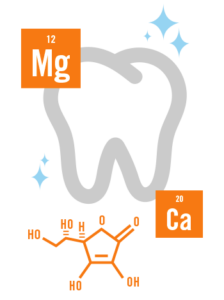How Do Cavities Develop?

Cavities develop when the foods we eat are exposed to the oral bacteria that naturally live inside our mouths. These bacteria feed on the food residues, creating acidic byproducts that wear down the enamel of our teeth. This byproduct is commonly known as plaque which, over time, calcifies and becomes tartar. The increased buildup in plaque and tarter wears down the enamel of your teeth, resulting in cavities.
How Can I Prevent Cavities?
Key factors in cavity prevention include brushing and flossing regularly, maintaining good dental health, and getting proper nutrition. This includes regular dental checkups and a healthy diet that includes a variety of nutrients, including vitamin C.
Vitamins for Dental Health Found in Florida Orange Juice:
- Vitamin C – This powerful antioxidant helps build teeth, bones, cartilage and gums.1
- Magnesium – A healthy diet that includes magnesium is important for tissue and bone development. 1
- Calcium and Vitamin D (in fortified juices) – Both calcium and vitamin D build bone and teeth, and vitamin D also improves the absorption of calcium in the body.1
- Potassium – It’s important to keep bones healthy as the jaw bone provides a socket to surround and support the roots of the teeth. Potassium can play an important role in bone mineral density by aiding in acid-base balance to help reduce the risk of calcium lost from bones.
DID YOU KNOW?
The amount of time that your teeth are exposed to sugar is only one factor in cavity development. Food and beverages are not the sole cause of cavities!
Nutrition Research Corner for Health Professionals
Fermentable sugars are a factor in cavity risk. However, sugar intake alone is not the cause of cavities.2-4 A wide range of factors including personal behaviors (diet quality and dietary behaviors), oral characteristics (oral microflora, fluoride exposure, saliva production, plaque), oral hygiene and food composition and timing (exposure, frequency) also play a role. 2-5
100% Fruit Juice and 100% Orange Juice
There is varying information about the link between cavities and sweetened beverages. Canada’s Dietary Guidelines suggest that beverages that contain free sugars (including 100 percent fruit juice) have been associated with a higher risk of dental decay in children.6 However, a prospective study assessing carbohydrate consumption in children found no association between tooth decay and foods containing medium or high amounts of sugar.7 Two additional studies found no increased risk of cavities in low-income and minority children consuming 100 percent fruit juice 8,9 and a 1999-2004 National Health and Nutrition Examination Survey (NHANES) study in 2-to 5-year-old children found no association between 100 percent fruit juice intake and cavity risk.10
100% orange juice includes many nutrients known to support tooth and bone health, such as vitamin C, potassium and magnesium. Fortified juices also contain calcium and sometimes vitamin D. Together with good oral health habits, 100% orange juice enjoyed in moderation can provide key nutrients that can be part of a healthy diet.
References
- Canadian Food Inspection Agency (2018, May 11): Nutrient Function Claims. Retrieved June 12, 2019 from http://www.inspection.gc.ca/food/general-food-requirements-and-guidance/labelling/for-industry/health-claims/eng/1392834838383/1392834887794?chap=9
- Food and Nutrition Board, Institute of Medicine. Dietary Reference Intakes for Energy, Carbohydrate, Fiber, Fat, Fatty Acids, Cholesterol, Protein, and Amino Acids. Washington, D.C.: National Academy Press; 2005:265-324.
- Palmer. Nutr Today. 2017;52(2S):March/April.
- Gupta et al. ISRN Dental. 2013;519421.
- Evans et al. J Acad Nutr Diet. 2013; 113(8):1057-1061.
- Health Canada (2019): Canada’s Dietary Guidelines for Health Professionals and Policy Makers. Retrieved June 18, 2019 from https://food-guide.canada.ca/static/assets/pdf/CDG-EN-2018.pdf.
- Campain et al. Eur J Oral Sci. 2003; 111:316-325.
- Lim et al. J Acad Dent Assoc. 2014; 139(7):959-967.
- Evans et al. J Acad Nutr Diet. 2013; 113(8):1057-1061.
- Vargas et al. J Acad Dent Assoc. 2014;145(12):1254-1261.
